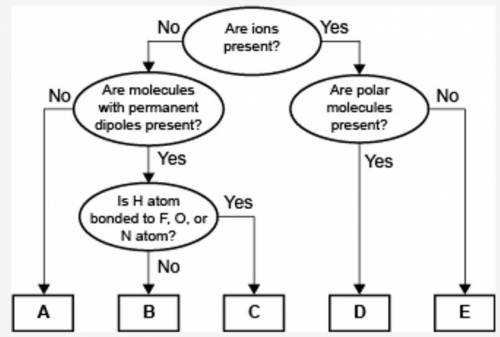
Chemistry, 18.12.2021 14:00 littleprinces
HELPPP
A concept map for four types of intermolecular forces and a certain type of bond is shown.
An ellipse is shown. Inside the ellipse is written Are ions present. An arrow from the right side of the ellipse has Yes written on it and points to another ellipse. This ellipse has Are polar molecules present written inside it. This ellipse has two arrows coming out of it. One arrow has Yes written on it and leads to a rectangular box that has D written inside it. The second arrow has No written on it and leads to a rectangular box that has E written inside it. An arrow from the left of the topmost ellipse has No written on it and leads to an ellipse that has Are molecules with permanent dipoles present Written on it. An arrow that has No written on it, points from this ellipse towards a rectangle that has A written inside it. An arrow that has Yes written on it, points from this ellipse towards another ellipse that has Is H atom bonded to F, O, or N atom Written on it. This ellipse also has two arrows coming from it. The arrow with Yes written on it leads to a rectangle that has C written on it and the arrow that has No written on it leads to a rectangle that has B written inside it.
Compare the relative strength of the two forces B and C. Explain how you determined this comparison by identifying the forces.


Answers: 3
Another question on Chemistry

Chemistry, 22.06.2019 05:00
Frictional forces acting on an object are often converted into energy, which causes the temperature of the object to rise slightly.
Answers: 2

Chemistry, 22.06.2019 10:10
When water dissociates, each water molecule splits into a hydroxide ion and a) h 3 o + b) a hydrogen atom c) a hydrogen ion d) h 2 o e) oh —
Answers: 2


Chemistry, 23.06.2019 02:50
For questions 1 and 2, consider the following experimental data.hydrogen emission lines were detected at the following wavelengths (in nm): 121.6102.697.395.093.8question 1use the electromagnetic radiation classifications below and figure 1-1 in the introductory information for this lab (in the lab manual) to determine the nf value for the experimental data provided? wavelength, ? (nm) 650 700 550 600 400 450 500 visible spectrum wavelength, ? (m) 11 10 3 10 10 10 8 10 5 10 10 -10 10 9 10 10 10 10 -12 10 microwave radio infrared x-ray ultraviolet gamma 1020 1019 1018 1 1016 015 1014 01 12 109108 frequency, v (hz)a.1b. 2c. 3d. 4e. 5question 2using the data for the emission line with the longest wavelength, the known value of nf (from question 1 in this prelab), and the value of ni (deduced from the ? and nf values) calculate the rydberg constant for hydrogen (rh) in units of m-1.a) 1.097 x 10-11 m-1b) 5.921 x 107 m-1c) 1.097 x 10-2 m-1d) 9.252 x 106 m-1e) 1.097 x 107 m-1
Answers: 3
You know the right answer?
HELPPP
A concept map for four types of intermolecular forces and a certain type of bond is shown.<...
Questions

History, 02.08.2019 15:00


Biology, 02.08.2019 15:00




Biology, 02.08.2019 15:00

Business, 02.08.2019 15:00



Mathematics, 02.08.2019 15:00




Mathematics, 02.08.2019 15:00

Business, 02.08.2019 15:00


Arts, 02.08.2019 15:00




